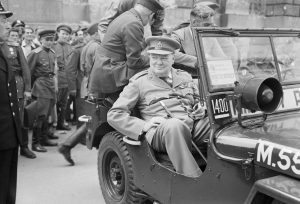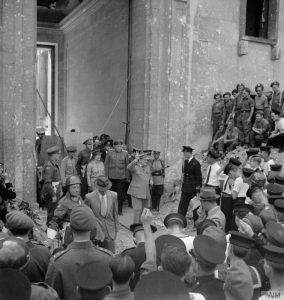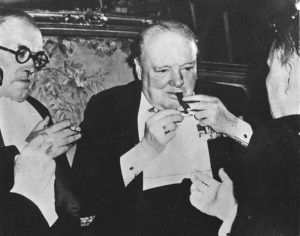
Finest Hour 162
Munich and Its Alternative: The Case for Resistance
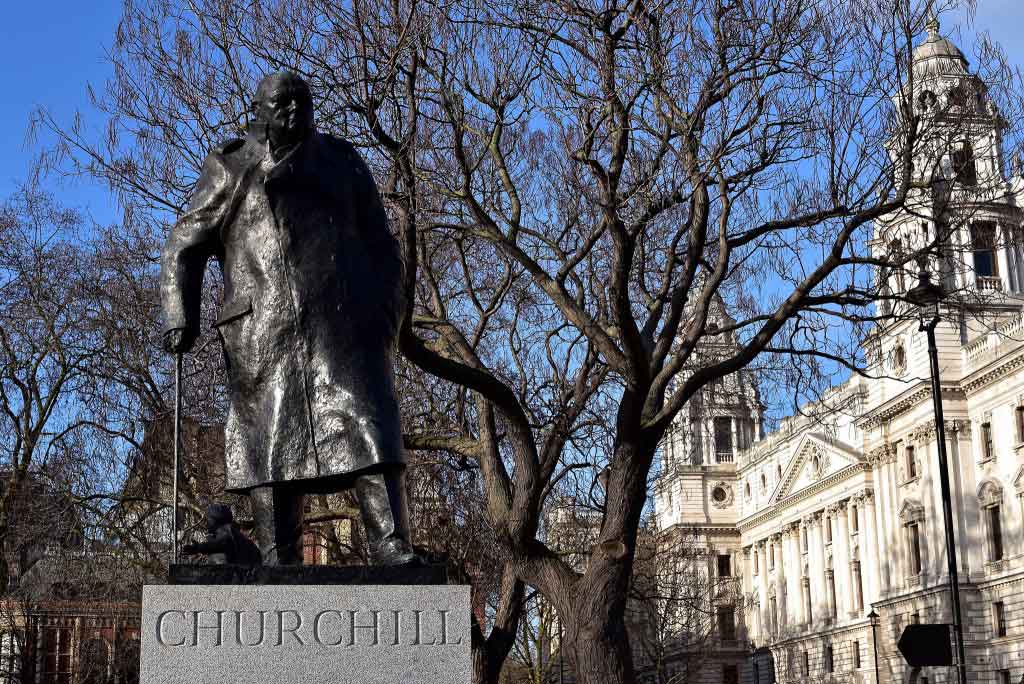
Winston Churchill, Parliament Square, London © Sue Lowry & Magellan PR
February 13, 2015
Finest Hour 162, Spring 2014
Page 16
By Williamson Murray
“You have only to look at the map…to see that nothing that France or we could do could possibly save Czechoslovakia from being overrun by the Germans, if they wanted to do it. I have therefore abandoned any idea of giving guarantees to Czechoslovakia, or to the French in connection with her obligations to that country.”
—Neville Chamberlain to his sister, 20 March 1938
“How erroneous Mr. Chamberlain’s private and earnest reasoning appears when we cast our minds forward to the guarantee he was to give to Poland within a year, after all the strategic value of Czechoslovakia had been cast away, and Hitler’s power and prestige had almost doubled!”
—Winston S. Churchill, The Gathering Storm, 1948
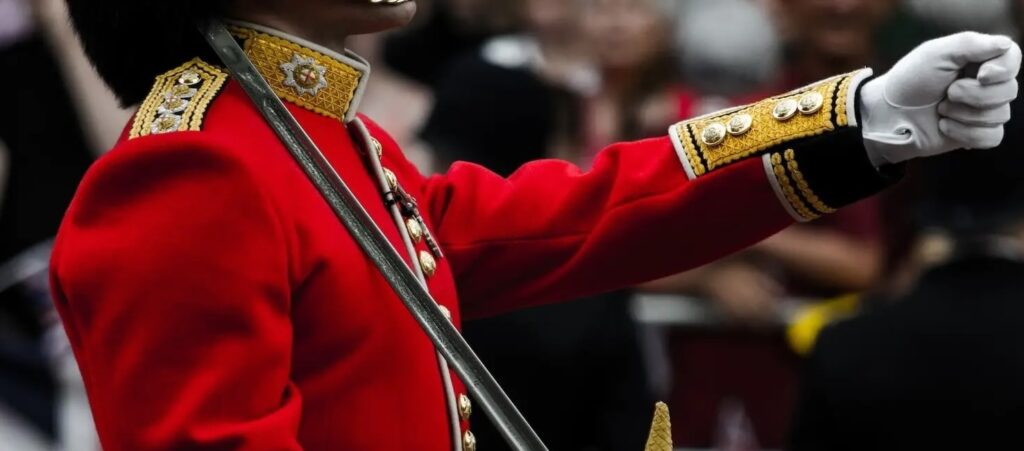
2024 International Churchill Conference
“In consequence of Wehrmacht demands and unlimited construction on the Westwall, so tense a situation in the economic sector occurred that the continuation of the tension past October 10 would have made a catastrophe inevitable.”
—Reich Defense Committee, October 1938
The theory that Neville Chamberlain saved Britain from a military and strategic defeat by his surrender to Adolf Hitler’s demands at Munich has been around for decades, and was cited by a professor at the last Churchill conference. In terms of the strategic and military situation in 1938, this theory could not be more incorrect.
Like most people, too many historians possess linear minds, and seem to believe that were one historical event changed, everything else would remain the same. Thus many defenders of the Munich surrender argue that, had war broken out in autumn 1938, the Germans would have conquered the Czechs just as quickly as they did the Poles the following year. Then, in spring 1939, they would have destroyed the French as quickly as in 1940, turning on a defenseless Britain, which would have had an insufficient number of Hurricanes and Spitfires to defend itself against the Luftwaffe.
What such reasoning misses are the enormous changes in the balance of military power and the overall strategic situation that actually occurred between autumn 1938 and when war actually broke out in September 1939. At the time of Munich, the Germans were extraordinarily weaker than they would be a year later. Here then is a modest lesson for scholars and others who are contemptuous of military and strategic history, but happy to comment on it when the occasion suits them.
To judge the question properly, we must consider the preparedness of the three German military services for a major war in 1938; the overall economic and strategic situation at the time of Munich; and the results of Western policies in the months following Munich. None of this will suggest that the Western Powers in 1938 confronted a desperate strategic situation leading inexorably to defeat. What really matters is the actual context within which the military power of the West would have confronted war and Nazi Germany in 1938.1
German Vulnerabilities
The German army in late summer 1938 was just completing the first stages of its rearmament programs. It possessed only three armored divisions, all of which were equipped with light tanks, obsolete even by standards of the time. One year later, it would possess six panzer divisions, which it would buttress with the first runs of Mark III and IV medium tanks.
The Germans would find the Czech tanks they seized in March 1939 quite useful; three of the ten panzer divisions that invaded France in May 1940, including Rommel’s famous Seventh Panzer Division, would be equipped with Czech tanks. In May 1940, those ten panzer divisions would just manage to break through the French defenses in the Ardennes. It is hard to see how 1938’s three divisions of light tanks could have achieved the smashing victories Hitler wanted in either autumn 1938 or spring 1939.
While in a strategic sense the Czech position seemed hopeless, tactically their country was far more defensible than Poland would prove the following year, surrounded as Czechoslovakia was by major mountain chains.
Moreover, Czech equipment was much more up-to-date than that of the Poles, while the German army was far smaller and less robust than it would be the following year. In 1938, the Germans had barely enough divisions to handle a major campaign against Czechoslovakia. Only a handful of divisions were available to defend against any French incursion—there would undoubtedly have been few of those—and if the Poles intervened they would have tied up von Rundstedt’s army in Silesia.2
Hitler’s seizure of the rump of Czechoslovakia in March 1939 made for dramatic changes in the situation over the following year. Captured Czech armaments allowed the Wehrmacht to equip no fewer than four of its infantry divisions, as well as all of the Waffen SS divisions that would invade France in 1940. In addition, the Germans would sell a substantial portion of the arms dumps they seized to the Balkan countries for the hard currency their economy desperately needed. Czech defense industries such as the Skoda Works, and Czech stockpiles of raw materials and foreign exchange, would significantly aid the Germans in their continued armament efforts. Ironically, the Skoda Works would remain the last major industrial concern still producing armaments for the Wehrmacht in 1945.3
If the German army was unprepared for war in 1938, the other two services were in even worse condition. That summer, the Luftwaffe’s combat squadrons were evolving a new generation of aircraft—the stress-winged monoplanes that would dominate World War II. But its operationally-ready rates were barely over 50 percent, while its pilots were still largely untrained. The result was 1937-38’s accident rate, horrendous even by the standards of the time. After the crisis was over, the Luftwaffe’s chief of supply noted that the consequence of these circumstances was “a) a constant, and for first line aircraft, a complete lack of reserves both as accident replacements and for mobilization; b) a weakening of the aircraft inventory in the training schools in favor of regular units; and c) a lack of necessary reserve engines, supplies for the timely equipment of airfields, supply services, and depots both for peacetime needs as well as for mobilization.”4
Strategically, the Germans were also unprepared to launch major bombing attacks against the United Kingdom. One member of the air staff of Second Air Force noted that his service only possessed the ability to inflict pinpricks on the British.5 Based in Germany, far from the English Channel, and possessing only obsolete twin-engine bombers, the Luftwaffe was in no position to match the efforts it made in summer 1940 during the Battle of Britain—and it is well to remember how dismally those efforts failed.
The German navy was worse off than the Luftwaffe. No major fleet units, on which Hitler was lavishing so many resources, were ready for deployment in 1938; the only combat-ready units were three pocket battleships, in fact nothing more than glorified heavy cruisers. As for submarines, the navy possessed only a handful, none of which were fully combat-ready. They could have made only a few desperate forays against British trade, which would not have had serious impact on the overall strategic situation. The German navy could not even execute an invasion of Norway, which succeeded only by the barest margins in April 1940, and at a cost of virtually the entire German fleet.
As dubious as Germany’s military situation in 1938 was the Reich’s overheated economy, a result of the massive rearmament Hitler had launched when he took power in 1933. This in turn posed serious difficulties in accessing raw materials crucial to a major armaments program. One does not wage a major war without access to raw materials or at least significant stockpiles; yet this is what Hitler threatened to do at Munich, much to the consternation of his generals (see following article).
The only raw material Germany had in abundance was coal. It did have some deposits of iron ore, most of it with a low percentage of iron content. Imported high-grade French and Swedish ore was essential to the functioning of a steel industry on which the war effort would depend. But war with the West would cut off the French supply, while Swedish ore would be problematic unless the Germans could seize Norway, which they were in no position to do in 1938.
Every other major raw material, including oil, rubber, manganese and aluminum, was either in short supply or non-existent on German territory. In peacetime Germany bought those materials with its limited hard currency: thus, German industry was unable to supply 59 percent of the Wehrmacht’s orders in the period before the war.
In 1939-40 the Germans would receive considerable help from the booty they seized in Czechoslovakia, as well as supplies received from the Soviet Union. In 1938 those stockpiles were not at their disposal. Russian aid only began to accelerate after the signing of the Nazi-Soviet Non-Aggression Pact in August 1939.
The Anschluss with Austria in March 1938 brought a mild improvement in the German economic picture, but Hitler’s massive war preparations—mobilization against the Czechs, and the Westwall to protect the Franco-German frontier—created what was close to an economic crisis. By October 1938 the lack of foreign exchange had forced many rearmament industries to begin using emergency stockpiles. Petroleum stocks were almost exhausted when the Rumanians indicated at the end of September that they were about to shut off exports to the Reich. In early October the Reich Defense Committee reported that “in consequence of Wehrmacht demands and unlimited construction on the Westwall, so tense a situation in the economic sector occurred (coal, supplies for industries, harvest of potatoes and turnips, food supplies) that the continuation of the tension past October 10 would have made a catastrophe inevitable.”6
Armament decisions by Hitler and his advisers underline the seriousness of Germany’s economic situation. In January 1939 Hitler announced a great export drive, but his speech was really a smokescreen to cover his massive cuts in the allocation of raw materials to the armed services. The Führer cut Wehrmacht steel allocations by 30 percent, copper by 20 percent, aluminum by 47 percent, rubber by 14 percent, and cement by 25-45 percent.7
Not only was the 1938 German economy unprepared to bear the burdens of a major conflict, but war with the West would inevitably entail a British naval blockade that would halt the great majority of German imports. In 1939, the Germans would find the Soviets willing to help them avoid the full impact of a British blockade. But there was little chance of Russian assistance in 1938.
Would the German economy have collapsed under the pressures of war in 1938? Undoubtedly not, but it certainly could not have supported a major war. Indeed these prevailing economic difficulties convinced Hitler to occupy the remainder of Czechoslovakia six months after the signing of the Munich Agreement, finally awakening the British and French, although not necessarily their leaders, to the fact that Nazi Germany represented an unavoidable danger.
The Anglo-French
If Germany was not ready for war in 1938, neither were the Western Powers. Nonetheless, the Allies would be in an even more dangerous situation by 1939. At the time of Munich, their navies were unchallenged. In terms of air power, the French were considerably behind the Germans,8 while the RAF was beginning serial production of both Hurricanes and Spitfires. Although the British had not yet built up their defensive forces to provide the solid shield they would possess in 1940, it did not matter, because the Luftwaffe as yet lacked the means to launch effective strikes against the British Isles.
In terms of preparedness and doctrine, the French Army remained firmly mired in the First World War. Again, that was less of a problem in 1938, when modern German armored forces were so few in number, incapable of striking a deep and effective blow. German military leaders were well aware of their weakness. A memorandum by one senior naval officer warned: “A war against England and France means, militarily speaking, a lost war for Germany with all its consequences.”9 The chief of the German General Staff, General Ludwig Beck, was equally forthright in his warnings.
Two factors contributed mightily to the surrender at Munich. First, the terrible impact of the First World War’s losses weighed heavily on the British and French people—so much so that their leaders simply couldn’t believe Hitler would actually consider war as a realistic option. Second, a series of strategic appreciations which the French and British military ground out in large numbers during spring and summer 1938 uniformly bemoaned how desperate was the strategic situation. The British chiefs of staff, I suspect, painted a gloomier picture than they need have, hoping to push the government to greater defense allocations.
These dark military forecasts certainly encouraged the policy of appeasement, though on several occasions that arch-appeaser, Lord Halifax, told his colleagues that if it came to war, the Allies would probably win. Yet, in their almost endless discussions of the strategic situation, Chamberlain’s Cabinet left out perhaps the most important question of all: what would the strategic situation look like if the British and French handed over Czechoslovakia, and then had to fight the Germans a year later? Oliver Stanley, President of the Board of Trade, actually raised that question, but so late that the chiefs of staff never completed a study of the matter, and it was never discussed in Cabinet.
Post-Munich Failures
What happened after Munich underlines the weaknesses in Allied understanding of how dangerous a situation they now confronted. Politically, Chamberlain found himself in a conundrum. Through the summer of 1938, he and his supporters had cited British military unpreparedness to persuade waverers among their supporters, who were finding further appeasement repugnant. Having done so, the Prime Minister found himself under pressure to repair those deficiencies. Publicly, he announced that that was precisely what the government would do. But one of his chief advisers, Sir Horace Wilson, told him the government should make no changes in defense policies lest it provoke the Germans. Defense thus fell between two stools: promises of more, but little change at a crucial time.
Only minimal increases in defense spending occurred in the six months following Munich. Although the army had been capable of sending only two under-equipped divisions to the continent in September 1938, Chamberlain resisted all efforts to increase its budget until late February 1939, when it became clear that the French might not be willing to stand by the British should the Germans invade Holland as a precursor to launching attacks on the British Isles. The navy received funding for a few minesweepers and twenty escort vessels; the dredging of Dover and Rosyth harbors; an airfield at Scapa Flow; and permission to order armor plating from Czechoslovakia—hardly impressive increases in spending.
Supporters of Chamberlain’s action at Munich have argued that it allowed Britain to repair its weakness in fighter aircraft. In fact, the Cabinet increased the number of fighters on order only by extending the two-year contract to three years. There were no production increases of Hurricanes and Spitfires after Munich, even though British factories were turning out fighters at a faster rate than contracts called for. In effect, the six months after Munich represented a wasting period that did nothing to repair the deficiencies of Britain’s defenses. All the while, the Germans were urgently attempting to increase military production in spite of their economic difficulties.
It has often been claimed, as recently as at the 2013 Washington conference, that Churchill, confronted by the gloomy prognostications of the chiefs of staff, would have taken the same path at Munich as Chamberlain. But on 23 September 1938, the British chiefs of staff produced a far more optimistic paper than they had earlier. “Until such time as we can build up our fighting potential,” they wrote, “we cannot hope for quick results. Nevertheless, the latent resources of the Empire and the doubtful morale of our opponents under the stress of war give us confidence as to the ultimate outcome.”10
Their newfound optimism probably reflected intelligence coming out of the Third Reich as to how badly prepared for war the Germans really were in 1938. Some of that intelligence had come from representatives of the German general staff itself—intelligence that Neville Chamberlain dismissed.
Had Churchill been prime minister, based on his habits when he did come to lead, there is no doubt that he would have paid closer attention. He would certainly have challenged the pusillanimous, worst-case staff studies produced by various military committees that made up the British high command. But in 1938 Churchill was neither prime minister nor a member of the Cabinet. He was still in the wilderness, a frustrated observer as his country lurched toward disaster.
Dr. Murray is professor emeritus at Ohio State University, adjunct professor at Marine Corps University, and author or editor of many books on military history, strategy and theory. His latest book, Moment of Battle, with James Lacey, covers twenty crucial battles in history. His next book, on the 1980-88 Iran-Iraq War, will appear this summer.
Endnotes:
1. For a more detailed discussion of the military and strategic issues involved in the Czech crisis see Williamson Murray, The Change in the European Balance of Power, 1938- 1939: The Path to Ruin (Princeton, N.J.: Princeton University Press, 1984), especially chapters 6, 7, and 8.
2. The Poles were on the fence. If the French and British came in, they hoped to attack the Germans. If the French and British stayed out, they hoped to grab some of Czechoslovakia (and did: see page 29), but this might have involved them in a war with the Soviets. The political-diplomatic situation was precarious in autumn 1938 and no one can predict how the dominoes might have fallen in the various scenarios.
3. Chris Bishop, Encyclopedia of Weapons of World War II (New York: Sterling, 2002), 128.
4. Milch Collection, Imperial War Museum, Reel 55, vol. 57, Der Chef des Nachschubamts, Nr. 3365/38, 3 November 1938.
5. Ibid.
6. National Archives and Records Service Microfilm T-1022/3048/PG33272, Reichsverteidigungsausschuss, 15 December 1938.
7. Ibid.
8. The French, who had invested minimal sums in aircraft development, were two years behind the Germans and a year behind the British. Introducing revolutionary aircraft invariably leads to high accident rates and low commission rates. The Germans went through that process in 1937-38, the British in 1939, the French in 1940 Thus France had two outstanding fighter aircraft in May 1940 but their squadrons were 50-70 percent out of commission with lots of accidents. It all goes back to the disastrous industrial and defense policies of Leon Blum. See Murray, passim.
9. Bundesarchiv/Militärarchiv, K10-2/6, Captain Heye, “Beurteilung der Lage Deutschland-Tschechei,” July 1938.
10. National Archives (formerly Public Records Office) CAB 53/41, COS 773, COS Committee, “The Czechoslovak Crisis,” 24 September 1938.
Subscribe
WANT MORE?
Get the Churchill Bulletin delivered to your inbox once a month.
